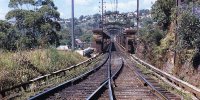I see that there was a short-lived thread on this subject earlier in the year but it’s no longer open for replies so I hope this new one is acceptable.
Use of interlaced track in the UK was evidently most common on tramways and examples still exist on the Croydon, Nottingham and Great Orme systems and at Crich, where space does not allow a normal double track or to avoid pointwork in the street.
I often wondered why this arrangement wasn’t use more on railways, e.g. through the narrow tunnels on the Hastings line when they were singled in the 1980s. Interlacing the track would have saved the cost of two sets of points at each tunnel and reduced the risk of delay in the event of points failure at what are probably fairly inaccessible locations. I suppose two conductor rails would be needed instead of just one on a single track but, provided that the line was signalled as a single track, what other objections could there have been to this arrangement?
Use of interlaced track in the UK was evidently most common on tramways and examples still exist on the Croydon, Nottingham and Great Orme systems and at Crich, where space does not allow a normal double track or to avoid pointwork in the street.
I often wondered why this arrangement wasn’t use more on railways, e.g. through the narrow tunnels on the Hastings line when they were singled in the 1980s. Interlacing the track would have saved the cost of two sets of points at each tunnel and reduced the risk of delay in the event of points failure at what are probably fairly inaccessible locations. I suppose two conductor rails would be needed instead of just one on a single track but, provided that the line was signalled as a single track, what other objections could there have been to this arrangement?

